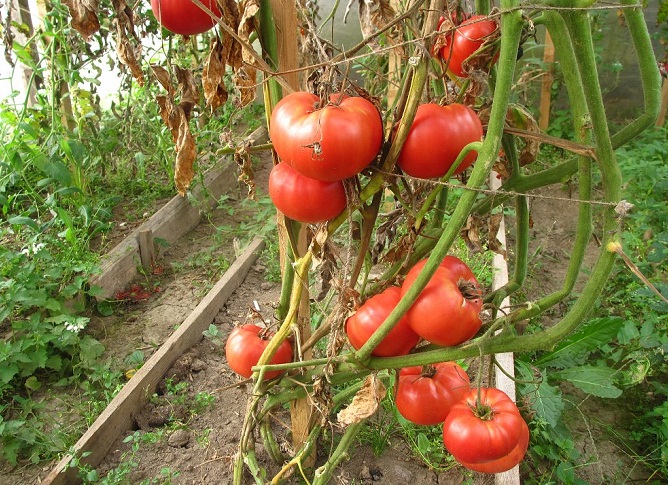 Variety Italian sweet it will attract the attention of lovers of large-fruited varieties with a sweet taste and juicy pulp of tomatoes, medium early ripening and high productivity.
Variety Italian sweet it will attract the attention of lovers of large-fruited varieties with a sweet taste and juicy pulp of tomatoes, medium early ripening and high productivity.
Content
Characteristics and description of tomato Italian sweet
The place where the tomato will be grown, the composition of the soil, your preferences (small, large fruits, tall or low bushes) play a big role in the choice of planting material. To do this, you should definitely familiarize yourself with the characteristics of the variety.
Variety characteristic:
- indeterminate;
- tall;
- mid-season;
- productivity - up to 5 kg from one bush;
- large-fruited;
- cultivation - greenhouse (middle lane);
- height - up to 2m;
- feature - medium leaf;
- stem formation - 1-2.
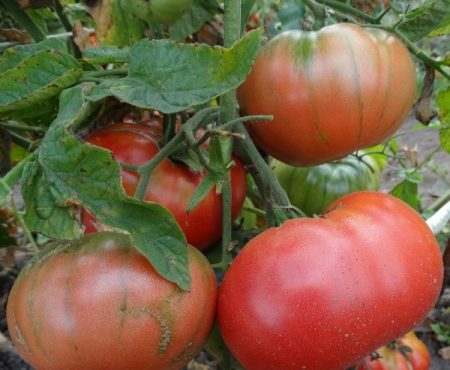
Description of the fetus:
- the shape is flat-round, with a slight ribbing at the peduncle;
- size - large;
- weight - 300-500g;
- color - raspberry;
- taste is sweet;
- pulp - fleshy;
- use - fresh consumption, in juices, sauces, lecho.
Growing tall tomatoes in a greenhouse
Growing tomatoes indoors is subject to certain rules that ensure a good harvest.
Tomato soil:
Information! Once every five years, the soil in the greenhouse needs to be updated.
- It is necessary to disinfect the soil - this helps to destroy pests and pathogens of infection. Disinfection Options: copper sulfate, dolomite flour (50g per 1m²) or hot boiling water. Tillage is best done after harvesting.
- The root system of tomatoes is sensitive to cold and in the autumn warm beds can be made for them: remove the soil (20 cm), lay straw, sawdust 10 cm thick, then a layer of compost (10 cm) and a layer of ground (20 cm). In spring, it is good to spill the beds with warm water.
- Fertilize soil with a lack of nutrients with organic matter from peat and humus (½ bucket per 1 m²), and pour sand and ash on top (1 liter per 1 m²). On top of the fertilized area, mulch with straw, in winter pour a layer of snow on it - snow will melt the soil when it melts.

- In the spring, plant green manure, and 14 days before planting seedlings, plant the greens in the soil by 2-3 cm.
- Dig the soil, making ready-made mineral fertilizers (according to the instructions).
Information! 3kg of green manure is equivalent to 1.5kg of manure.
- The transplant should be carried out in warm (10 ° -15 °) ground - at low temperatures, the roots of tomatoes do not develop well.
How to plant tall varieties
- Staggered: 55-60cm between the bushes, 75-80cm - between the rows when forming one stalk, 70-75cm - when forming two stems.
- The method of combined landingswhen both low and high bushes are planted at the same time, it has successfully established itself:
- in a row near the film (glass) to plant low bushes with early ripening of fruits -35-40 cm between them, form a bush in one stem;
- plant tall bushes at a distance of 60 cm near the aisle (formation in one stalk);
- in a row with tall bushes, retreating to the south about 10 cm, plant standard varieties at a distance of 25 cm from each other;
- remove early bushes after ripening.
Planting seedlings
- When the seedlings reach the age of 50 days, it is transplanted into the greenhouse.
- Water the plants before transplanting, cut long roots by 2-3cm.
- In the wells put ready humus (a handful) and pour a solution of potassium permanganate pale pink color (2 liters per well).
- Place a bush of seedlings together with a lump of earth in the hole to the bottom leaves, sprinkle with earth, which needs to be slightly compacted, pour mulch on top so that moisture evaporates less. Plant tall bushes obliquely.
- For prophylactic purposes, treat late blight with Bordeaux liquid (100 g per bucket of water) or copper chloroxide (40 g of copper per bucket).
- Do not water the seedlings for seven to ten days, do not loosen, and when it gets stronger, loosen the top layer slightly.
- Directly during planting, a support is installed so that then not to damage the roots.
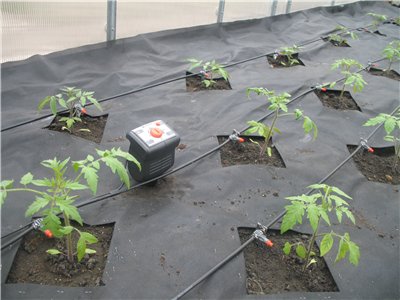
Removal of lateral shoots (pinching)
- When the height of the bushes is 15-20 cm, the first side shoots are removed. Broken off (or cut off) shoots can be put into a container of water to grow roots, and then planted. It is wise to use shoots when growing rare varieties.
- In a greenhouse, stepsoning should be carried out gradually (once every seven days).
- The lower leaves are also removed when the fruits begin to pour - the bushes are better ventilated and the fruits get more nutrients.
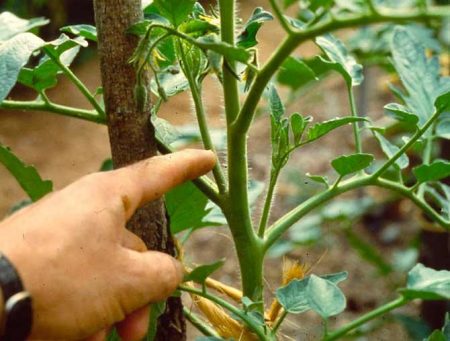
Tomato Care
- Treatment of infections with infusion of garlic up to seven times per season: chopped garlic (30-40 g) soak for a day in a bucket of water. Effective iodine with added water, placed in a greenhouse in an open container.
- Maintain daytime temperature 20 ° -25 °, nighttime temperature 16 ° -18 ° by closing (opening) transoms, doors.
- Perform the first watering in seven days. Water abundantly until fruit sets - 20-25l per 1m², then - 15-20l per 1m². If the soil, taken from a depth of 10 cm, crumbles in the hand, then you need to water it. Watering should be done with warm, settled water.
- After 8-10 days, carry out the first feeding, then every 10-12 days with alternating fertilizers (organic and mineral).
- Feeding during flowering: fertilizers with nitrogen - 25g, with potassium - 15g, with phosphorus - 40g per ten-liter bucket of water, consumption - 1l per 1 m².
- Feeding during the ripening period: insist 2 l of ash in 10 l of hot water, add iodine (pharmacy vial), boric acid (15 g) and stand for one day. Pour a solution of one liter of the mixture and a bucket of water - a liter per bush.
- Other types of top dressing:
- lack of nitrogen - the stem is thinned, frail, leaves are pale;
- lack of potassium - poorly developed roots, insufficient growth, wrinkled leaves of a blue hue;
- lack of phosphorus - leaves with purple veins and reddish spots, a thin stem.
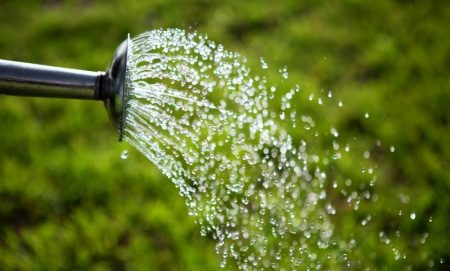
Harvesting and storage
- Collect fruits in the morning at temperatures above 8 °.
- Sort by laying brown separately, adding a few ripe tomatoes to them - they produce ethylene, which affects the ripening speed.
- Bushes with unripe tomatoes (to frost) together with the ground put in the basement, hanging on a hook (nail) with the stem down. Tomatoes will ripen by December.
- Well stored frozen tomatoes. Pour cold water before use.
Benefits of Tomato Italian Sugar
Benefits of Tomato Italian Sugar their characteristic features of the variety and growing conditions follow:
- high growth allows you to effectively use the area of the greenhouse;
- less green mass compared to other varieties;
- the possibility of forming two stems;
- productivity to 5 kg from a bush;
- large, sweet, fleshy fruits;
- delicious juices, sauces, lecho;
- average ripening;
- long fruiting.
disadvantages typical for tall tomatoes: pinching throughout the season and garter to the support of the stem and brushes several times during the season.
Reviews
Helena
Tomato Italian sweet lives up to its name: sweet, tasty, fleshy fruits. Tomatoes are large in size. Growing in a greenhouse: bushes are high - about two meters, the yield arranged me, formed three stems. Bottom line: I liked the variety.
Stepan Sergeevich (Kurgan region)
The Italian sweet attracted the first name, decided to check whether the tomato is really sweet. They write that it’s sweet, but is it really so? The result pleased: the tomatoes are sweet, fleshy, large. Grown, as recommended, in a greenhouse. He planted, however, not many bushes - only five, but I had enough for a trial sowing. I’ll plant more today - I love fleshy and sweet tomatoes. I recommend this variety. Of course, in general, salting is not suitable, but you can cut it if you really want to salt it. We plant not only for blanks, but also in the summer to enjoy what we like.




 Low-growing tomatoes, without pinching: 5 of the most delicious varieties
Low-growing tomatoes, without pinching: 5 of the most delicious varieties Why tomato seedlings grow poorly
Why tomato seedlings grow poorly We grow a tomato in a shell
We grow a tomato in a shell Growing tomatoes without watering according to the method of Kazarin
Growing tomatoes without watering according to the method of Kazarin